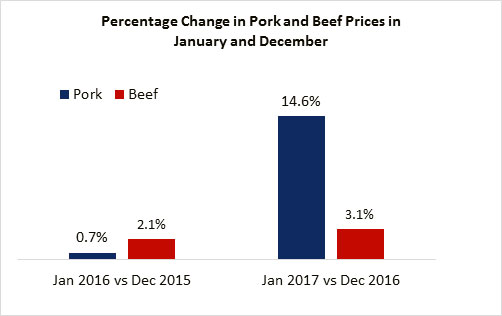Indexes
 31
January
2017
31
January
2017

 31
January
2017
31
January
2017
By the end of January, food prices in Tbilisi’s major supermarkets had increased by 7.2% compared to December 2016. Although prices increased m/m, there was a slight decrease in prices y/y. Food prices declined by 5.5% compared to January 2016.
Most of the prices increased when analyzed on a biweekly basis. Pork, coriander, and butter experienced the most drastic price increases since the middle of January. Pork prices increased by 29.8%, whereas coriander and butter gained in value by 24.0% and 8.4%, respectively. In contrast, eggplants, cucumbers, and tomatoes became cheaper by 20.2%, 8.9%, and 5%, respectively.
During the entire month of January, meat prices were particularly notable for their increase. If during the previous years the end of fasting period was the major cause of this increase, this time there are quite interesting changes in trade data that might be responsible for high meat prices. In the category of live bovine animals only, Georgia’s exports increased tremendously. Georgia exported approximately 12 thousand tons of live bovine animals in 2014, a bit more than 10 thousand tons in 2015, but in 2016, it exported more than 20 thousand tons. Thus, Georgia’s exports in this category increased by 92.3% in 2016 compared to the previous year. Interestingly, during the previous years, the major buyer of Georgian live animals was Azerbaijan; in 2016, almost 85% of live animal exports went to Iraq.

The increased export of live animals reduced the supply of meat to the local market, causing higher prices for both beef (the price of which increased by 5.3% m/m), and pork, as a result of the substitution effect between these two products. Once beef becomes scarce and expensive, consumers switch to pork, and due to high demand, the latter’s price increases as well. If the trend of local currency depreciation continues, one may expect an even higher rate of exports and therefore higher prices in the future.





